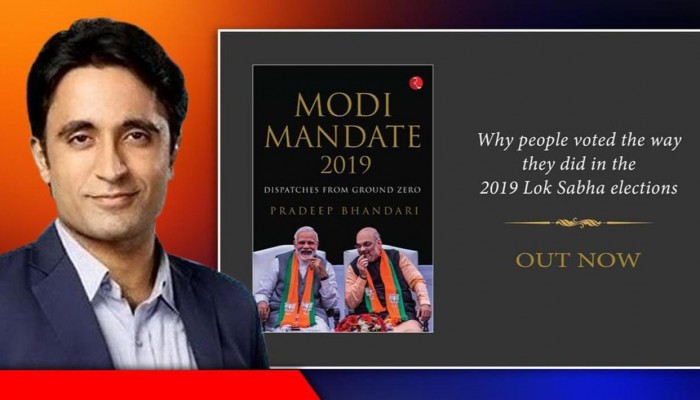Review of Pradeep Bhandari's Book- “Modi Mandate 2019: Dispatches from Ground Zero”
- In Book Reviews
- 01:01 AM, Apr 11, 2020
- Mukul Asher
This is an absorbing, unconventional, and engagingly written book by Pradeep Bhandari, India’s leading psephologist, with a unique approach to analysing elections, reflected in the subtitle of the book ‘Dispatches from Ground Zero”. He visited over 400 (out of 543) constituencies during the 2019 Lok Sabha election. He often succeeded in eliciting candid and insightful observations of common voters, not shared with others who do not connect as well with them. Bhandari’s professional record suggests that he uses this privilege responsibly, from the perspective of core national interests, and for substantive and relevant analysis rather than for short-term gain, another trait that sets him apart from many in the Indian media industry.
His approach exemplifies the hands-on style and philosophy of the young election analyst, who has made understanding the local context, and incorporating the views, often neglected, of local common people making up bulk of voters.
He therefore practices the spirit of the term psephology, a branch of political science concerning analysis of elections. The term comes from the Greek word psephos, meaning pebble. It is the micro-level analysis, and letting the individuals from different groups and regions of the country express their candid views that makes the book absorbing. In his election analysis, he does not restrict himself to numbers, but incorporates his assessment of the “feel” that local context generates.
He has a very credible record of analysing Indian elections in recent years. His presence on T. V., print and other media, both in English and in Hindi, and his ability to put his audience from all levels of society at ease, makes this young analyst stand out from his peers and competitors. It is uncommon in Indian media to have fluency in both English and Hindi that Bhandari exhibits.
His brand Jan Ki Baat which produces programs, polls, and other material based on vetted citizen reporters has been steadily commanding respect as noted by Meghnad Desai in his foreword to the book. He anchors a successful Hindi T. V. show Lalkar on Republic Bharat where citizens can participate.
Organization of the Book
The 221-page book comprises nine chapters, plus conclusions and way forward. Each chapter analyses progress of the 2019 elections in a state or in a small group of related states. After a broader discussion of the election, each chapter provides a succinct summary of the election in key constituencies. As Bhandari had visited over 400 constituencies, these succinct summaries provide lot of insights in the complexity of the constituencies, and how local or state election preferences are formed, and how these often differ from the national elections.
In the 2019 elections, out of 543 seats, the BJP won 303 seats, the Congress Party 52 seats, and the rest were divided among various other regional parties. The NDA of which BJP is a key component won 353 seats. This result was secured on the basis of the NDA’s performance under the leadership of Prime Minister Narendra Modi during the 2014-19 period. There are few parallels of democratically elected leaders receiving such mandate for the two consecutive terms anywhere in the world.
Let me comment on the selected chapters.
The book begins with a 32 -page chapter (titled “Where the Opposition Blew the War Trumpet”) analysing how election was contested in the state of Uttar Pradesh, where leaders of the traditional rivals, Samajwadi Party, and Bahujan Samaj Party got together to fight the election against the BJP led by Prime Minister Narendra Modi. His summaries of the contest in Gautam Buddh Nagar, Baghpat, and Kairana are particularly well sketched. In the 2019 election, out of 80 seats allocated to Uttar Pradesh, BJP won 62, BSP 10, and SP 5, negating the hopes that the coalition had for UP and elsewhere.
Among the important positive developments from the 2019 UP elections has been the emergence as a national political figure of Yogi Adityanath of BJP (who has been Chief Minister of UP since March 2017). His competent and professional management of CoVID-19 virus crisis, originating from China, currently facing India (and the world) is reinforcing his stature as a national political figure. If BJP and its allies succeed in securing mandate in the 2022 UP elections under the leadership of Yogi Adityanath, this will further reinforce his national stature.
The second chapter (28 pages) focuses on another key contest in West Bengal State, which the author terms “The Battle Between Regionalism and Religion”. Bhandari assesses the 2019 contest in the State as “…between fear, apparently created by the ruling party AITC (All India Trinamool Congress) led by Mamata Banerjee, and the glimmer of hope that the public was seeing in Modi.” (p.33). The Hindus in particular have felt alienated by the Mamata Banerjee’s policies and by the terror and intimidation its party workers unleashed, and which they have continued even after the 2019 Lok Sabha election. The people, with their ingenuity, followed the slogan “chup chaap Kamal chhaap” (keep silent and press Kamal symbol). Kamal or Lotus is BJP’s election symbol.
In 2019 elections, BJP increased its seats from West Bengal from 2 in 2014 to 18, while AITC won 22 seats. The vote share difference between the two was only 3 percentage points, 40.2 for BJP and 43.3 for AITC. The state assembly elections in West Bengal are scheduled for 2021.
Chapter 3 (18 pages) bring out the crucial role of women voters, and the impact of various social schemes by the NDA and by its ally at the State government level on them, as among the important factors explaining why NDA secured 39 out of 40 seats in Bihar.
Chapter 4 (20 pages) covers states of Rajasthan. Madhya Pradesh, Jharkhand, and Chhattisgarh, what the author calls Hindi Heartland of the country. His analysis of in spite of reverses experienced by BJP in state assembly elections in these states, BJP was able to secure overwhelming number of seats in each of these states. He credits the sophistication of voters for this outcome.
Chapter 5 (28 pages) analysis, what the author Calls “strategic wins”, discusses elections in Maharashtra and Gujarat states. BJP’s decision to align with Shiv Sena party was effective during the 2019 election, as BJP won 23 and Shiv Sena 18 for a total of 41 out of 48 seats. But since then, Shiv Sena has chosen to align with Indian National Congress and Nationalist Congress party to form the state government. This has changed the dynamics of the Maharashtra politics.
In Gujarat, the BJP won all 26 seats, overcoming earlier reverses in the state elections.
Chapter 6, (16 pages) describes how BJP secured all seven seats, overcoming the state level dominance of the Aam Aadmi Party (AAP). In this case also, voters showed differing preferences between the state and national elections. This trend was reconfirmed when in February 2020, Delhi voters elected AAP in assembly elections, giving it 62 out of 70 seats.
Chapter 7 (25 pages) focuses on the Northeast States and on Odisha. The chapter acknowledges that the NDA government, since being entrusted with governance responsibilities in 2014, has made commendable efforts to bring the Northeast region in the mainstream. Physical and digital connectivity has been improved, and long-standing insurgencies have been satisfactorily addressed. The 2019 elections have also led to the emergence of new young leadership in the region. In this connection, Chief Minister of Assan Sarbananda Sonowal; Himanta Biswa Sharma, convenor of North-East Democratic alliance (NEDA), of which BJP is a part; and Pema Khandu, Chief Minister of Arunachal Pradesh.
Bhandari reports that NEDA will need to be more adept at how sensitive issues, including CAB (Citizenship Amendment Bill), and NPR (National Population Register), essentially 2021 population census, which is routinely conducted every 10 years, are communicated and implemented in the Northeast.
In Odisha, BJP was against popular long serving (since 2000) Chief Minister Navin Patnaik of Biju Janata Dal (BJD). Bhandari reports that superior organization of BJD, and good governance at the state level meant BJP could make gains, but not as impressive as in West Bengal. Even then, BJP won eight seats, out of 21, a gain of 7 seats.
Chapter 8 (21 Pages) covers Uttarakhand, Himachal Pradesh, Haryana, Punjab, and Jammu and Kashmir (now divided into two Union Territories). Among these entities, BJP, and its alliance partner Shiromani Akali Dal won only 4 out of 13 seats, with 8 won by Congress. Bhandari explains the reasons behind this result well. In Haryana, BJP was able to overcome earlier local election reverses to win all 10 seats. Main reasons were appreciation of BJP’s nationalist credentials, and various central and state government schemes improving amenities and services, and enhancing the status of women. However, in October 2019 Assembly Elections BJP, while the single largest party, had to form an alliance with others to form the government. This again exhibits how voters differentiate between state level and national level elections.
The last chapter (21 pages) covers South India, where with the exception of Karnataka, where BJP won 25 out of 28 seats, its performance was poor. Contrary to the national trend, Kerala,voted for Indian National congress, and Tamil Nadu (39 seats) went for Dravida Munnetra Kazhagam, DMK). He also explains why regional parties are strong in Andhra Pradesh (25 seats) and Telangana, though in the latter BJP did win 4 out of 17 seats. Bhandari assesses that the BJP will need to devote more resources and efforts, and build regional alliances, to improve its performance in these states in the future.
Key Broad Findings
The key findings of the book (pp213-217) may be summarized as follows.
First, Bhandari finds evidence of improvement in effective delivery of public amenities and services that enhanced human dignity of the individuals and addressed the long-felt needs of the people. These included- health care, agriculture improvements, and crop insurance for risk management, affordable housing, toilets and improved sanitation and public hygiene, physical and digital connectivity infrastructure. The financial inclusion initiatives, did have a positive impact on voter behaviour. Broadly, NDA’s good record on vikas helped in many, though not all, constituencies. Importance of the quality of candidates and their service to the constituency at both the Union and the State levels has also increased.
This factor has concomitantly reduced the role played by dynastic politics in election outcomes. There is also no single dominant group or medium that is now able to monopolize the national narrative as in the past.
Second, Bhandari finds that voters have set preferences towards parties and candidates for local, state and national level elections. Nationalism, and NDA’s strong national security responses as compared to weak stance taken by the Congress and others did play a significant role in a number of constituencies. In states such as Bihar, Haryana and Rajasthan, this factor was important.
Fourth, Bhandari also finds that trust of the electorate in PM Modi’s leadership and in his intent (in Hindi neeyat) also played a role in the NDA’s solid performance in the 2019 election. A recent poll by Jan Ki baat finds that trust in PM Modi has continued since the election. It is my perception that PM Modi’s resolute and competent leadership in addressing the ongoing CoVID- 19 virus crisis will further contribute to enhancing trust in his leadership and in his neeyat among the people.
Suggestions:
There are two areas whose inclusion would have further enhanced the Book’s value.
First, in the 2019 Election, 615 million voters out of 912 million registered voted, for a participation rate of 67 percent. To organize such huge numbers over India’s large territory requires an organizational and institutional structure, as well acceptance of certain norms. A brief discussion of how elections are organized in India, including the role of Election Commission of India ((https://eci.gov.in/) would have been educational to many readers.
Second, the book would have been even more user friendly if data on 2014 and 2019 election results by State, by Union Territories, and by political Party were provided in an Appendix, with possible use of infographics.
The on-going China origin Covid-19 virus crisis being faced by India and the world will lead to profound changes domestically and globally. Their contours as yet can not be determined. But future Indian elections will not remain unaffected by the crisis.
Image Credits: Republic World







Comments